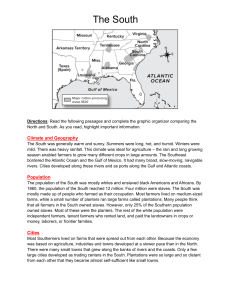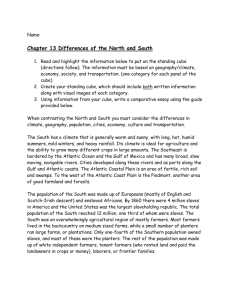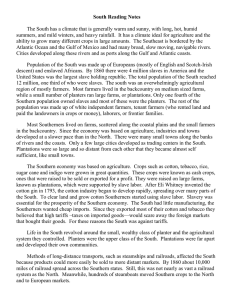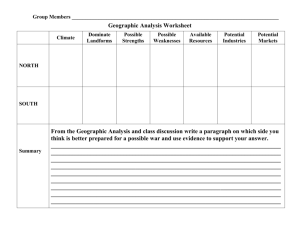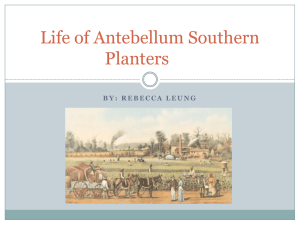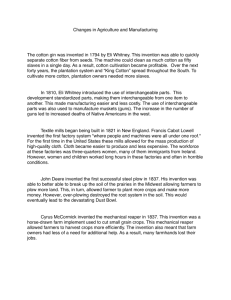Information about the North & South: Student Handout
advertisement
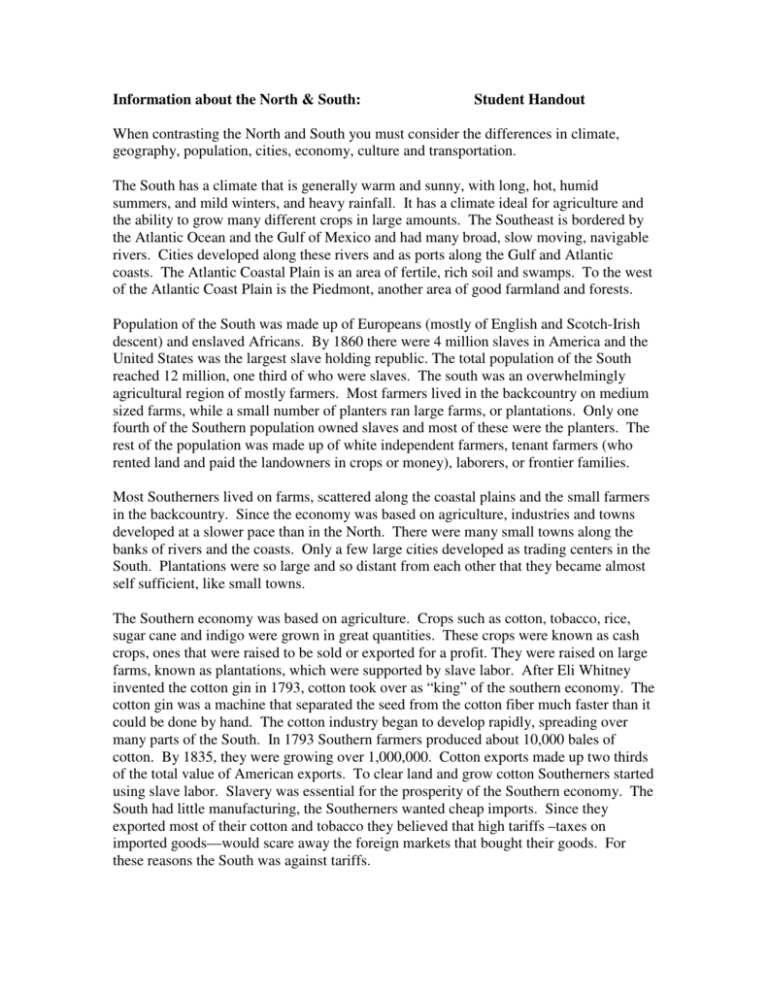
Information about the North & South: Student Handout When contrasting the North and South you must consider the differences in climate, geography, population, cities, economy, culture and transportation. The South has a climate that is generally warm and sunny, with long, hot, humid summers, and mild winters, and heavy rainfall. It has a climate ideal for agriculture and the ability to grow many different crops in large amounts. The Southeast is bordered by the Atlantic Ocean and the Gulf of Mexico and had many broad, slow moving, navigable rivers. Cities developed along these rivers and as ports along the Gulf and Atlantic coasts. The Atlantic Coastal Plain is an area of fertile, rich soil and swamps. To the west of the Atlantic Coast Plain is the Piedmont, another area of good farmland and forests. Population of the South was made up of Europeans (mostly of English and Scotch-Irish descent) and enslaved Africans. By 1860 there were 4 million slaves in America and the United States was the largest slave holding republic. The total population of the South reached 12 million, one third of who were slaves. The south was an overwhelmingly agricultural region of mostly farmers. Most farmers lived in the backcountry on medium sized farms, while a small number of planters ran large farms, or plantations. Only one fourth of the Southern population owned slaves and most of these were the planters. The rest of the population was made up of white independent farmers, tenant farmers (who rented land and paid the landowners in crops or money), laborers, or frontier families. Most Southerners lived on farms, scattered along the coastal plains and the small farmers in the backcountry. Since the economy was based on agriculture, industries and towns developed at a slower pace than in the North. There were many small towns along the banks of rivers and the coasts. Only a few large cities developed as trading centers in the South. Plantations were so large and so distant from each other that they became almost self sufficient, like small towns. The Southern economy was based on agriculture. Crops such as cotton, tobacco, rice, sugar cane and indigo were grown in great quantities. These crops were known as cash crops, ones that were raised to be sold or exported for a profit. They were raised on large farms, known as plantations, which were supported by slave labor. After Eli Whitney invented the cotton gin in 1793, cotton took over as “king” of the southern economy. The cotton gin was a machine that separated the seed from the cotton fiber much faster than it could be done by hand. The cotton industry began to develop rapidly, spreading over many parts of the South. In 1793 Southern farmers produced about 10,000 bales of cotton. By 1835, they were growing over 1,000,000. Cotton exports made up two thirds of the total value of American exports. To clear land and grow cotton Southerners started using slave labor. Slavery was essential for the prosperity of the Southern economy. The South had little manufacturing, the Southerners wanted cheap imports. Since they exported most of their cotton and tobacco they believed that high tariffs –taxes on imported goods—would scare away the foreign markets that bought their goods. For these reasons the South was against tariffs. Life in the South revolved around the small, wealthy class of planter and the agricultural system they controlled. Planters were the aristocracy—the upper class—of the South. They lived like country gentleman of England and ran the political and economic life of the South. Plantations were far apart and developed their own communities. Recreational activities included such things as fox hunting, dancing, horseracing, and watching cockfights. There were few schools or churches in the South, since neither education nor religion were very organized. The best educated were the sons of planters. On plantations there were sometimes small schools, and often planters hired private tutors to each their children until they were sent off to private schools. Small farmers had little or no education. Methods of long-distance transports, such as steamships and railroads, affected the South because products could more easily be sold to more distant markets. By 1860 about 10,000 miles of railroad spread across the Southern states. Still, this was not nearly as vast a railroad system as the North. Meanwhile, hundreds of steamboats moved Southern crops to the North and to European markets. The North has a climate of warm summers and snowy cold winters. The terrain is rocky, hilly, and not good for farming. These conditions along with a short growing season made farming difficult. Most of the forest was made up of timber used for shipbuilding. There are many sheltered bays and inlets on the Atlantic coast. Settlers found that ships could sail along wide rivers into many of these bays. Most of the rivers are fast, shallow, and hard to navigate. At a certain point, called the Fall Line—a plateau over which eastward-flowing rivers fell onto the plain—the many waterfalls of most rivers made them no longer navigable. At the Fall Line many ships dropped their cargo. Cities, which served as trading centers, grew up at these points. Soon people realized that the waterfalls were a cheap source of energy, and the waterpower began to be used to run factories. The period between 1800 and 1860 brought rapid population growth throughout the United States. In the North the overall population rose from about 5 million to 31 million during this time. Part of this increase was due to massive immigration. Between 1830 and 1850 along, over 2 million Irish, German and other northern Europeans arrived in the United States. Most of them settled in the North. Cities in the North thrived as centers of commerce. They were set up along the Atlantic coast and served as centers of trade between the North and Europe. They were hubs of manufacturing of textiles (cloth goods) and other products. Many people from rural New England moved to the cities looking for employment opportunities. In 1800 about 5 percent of the population lived in cities, but by 1850 nearly 15 percent did. Increased trade and manufacturing drew many laborers to town to work. Cities were often crowded and dirty. Not until after 1830’s were harbors and streets improved, sanitation systems were started, and police forces were created. Public services such as education began to take root. Cities were important centers of art, culture, and education. Most cities printed newspapers and books and provided many forms of recreation, such as dancing, card playing, and theater. The Northern economy was based on many different industries. These industries included shipping, textiles, lumber, furs, and mining. The majority of people lived on small farms and found that much of the land was suited for subsistence farming—raising food crops and livestock for family use—rather than producing goods to export, or send to other countries. Northerners stated to use their “ingenuity” to manufacture all kinds of goods. With the use of waterpower and coal for steam plants, manufacturing developed quickly. Items such as textiles, iron, and ships were manufactured in great quantities. These goods were traded for foreign products, transported to and from all continents by trading ships. To protect its industries from foreign competition, the North favored high tariffs, or taxes on goods coming in from other countries. The growth of trade, manufacturing and transportation brought many changes to cities in the North. Cities took on an increasingly important role in determining the culture of the North. Merchants, manufacturers, wage earners, and new business owners brought new ideas to the North. Merchants, manufacturers, wage earners, and new business owners brought new ideas to the North. The majority of Northerners were Protestant believers. Villages became strong centers of community activities. Both religion and education were organized institutes. Most towns had both schools and churches. Public education grew in the north after the 1830’s. Although, a minimum of boys went to secondary school, and college was reserved mostly for the wealthy. During the first half of the 1800’s transportation vastly improved and the size of the United States more than doubled. By 1860 there were over 88,000 miles of surfaced roads. Canals, mostly built in the North, were a cheap source of transportation. The Erie Canal was clearly a success for New York commercial activities. Many other cities began to follow suit and within a decade a system of over 3,000 canals provided water transportation between the Eastern seaboard and rivers in the West. Not long after the first railroad were laid, and by 1850, 30,000 miles of tracks connected distant parts of the United States. Most of the new rail lines were in the North.

